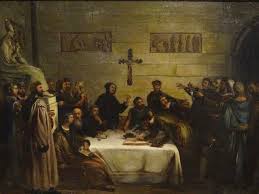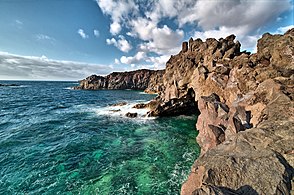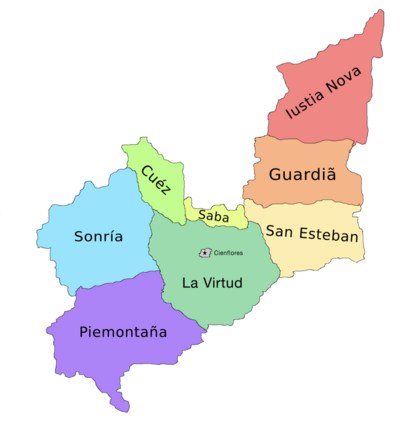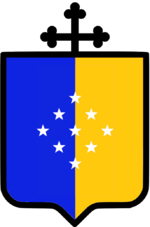Auratia
This article is incomplete because it is pending further input from participants, or it is a work-in-progress by one author. Please comment on this article's talk page to share your input, comments and questions. Note: To contribute to this article, you may need to seek help from the author(s) of this page. |
Commonwealth of Auratian Catholic States Mancomunidad de los Estados Católicos Oratianos (Auratian) | |
|---|---|
| Motto: "Quamdiu fecistis uni ex his fratribus meis minimis, mihi fecistis" (Solarian) "Inasmuch as ye hath done it unto the least of these my brethren, ye hath done it unto me" | |
| Anthem: El trueno debajo de noestros pies (The Thunder Beneath Our Feet) | |
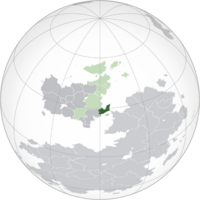 Auratia (dark green) and the Euclean Community (light green) in Euclea. | |
| Capital | Cienflores Puerto del Rey (Judicial) |
| Largest city | Villadad |
| Official languages | Auratian |
| Recognised regional languages | Iustian |
| Ethnic groups | 67% Oratiano 21% Iustian 5% Etrurian 3% Gaullican 2% Badawiyan 1% Bahian 1% other |
| Religion | 98% Solarian Catholic 2% other |
| Demonym(s) | Auratian |
| Government | Federal parliamentary constitutional republic |
| Enrique Santos Dominguez | |
| Germán del Caserío | |
| Piedro Probi | |
| David Salomón | |
| Legislature | Auratian Senate |
| Council of the States | |
| Assembly of the People | |
| Establishment | |
• Monarchy | 8 August 1573 |
• Republic | 13 January 1820 |
| 28 June 1868 | |
| Area | |
• Total | 240,886 km2 (93,007 sq mi) |
• Water (%) | 7.02 |
| Population | |
• 2016 estimate | |
• 2010 census | |
• Density | 137.1/km2 (355.1/sq mi) |
| GDP (nominal) | 2016 estimate |
• Total | |
• Per capita | $24,840 |
| Gini (2016) | low |
| HDI | high |
| Date format | dd.mm.yyyy |
| Driving side | right |
| Calling code | +109 |
| Internet TLD | .au |
Auratia (/ɔːˈreɪʃə/, Auratian: Oratia /oratja/), officially the Commonwealth of Auratian Catholic States (Auratian: la Mancomunidad de los Estados Católicos Oratianos), is a country comprised of eight States and one federal district located on the Auratian Penninsula in southern Euclea. It borders Gaullica to the northwest, Etruria to the southwest, the Sea of Assonaire to the north, and shares a maritime boundary with Emessa and Montecara to the south. The nation spans over 220,886 km2 and has an estimated population of roughly 33,020,000 people.
The Auratian Peninsula was first occupied by Tenic-speaking tribes who were subsequently conquered by and integrated into the Solarian Empire by 100 BC. The peninsula's position proved useful for the empire, serving as a jumping-off point for campaigns into central and northern Euclea and Coius. The Auratians were quick adapters of the Solarian Catholic Church, which still holds considerably sway in Auratian society today. After the fall of the Solarian Empire, the Auratian Peninsula was absorbed into the Verliquoian Empire, and the pensinsula was the focus of various invasion attempts by the marauding Tagamics and Irfanic Heavenly Kingdom. By the turn of the millenium, the Auratian princes grew increasingly hostile towards Verliquoian rule, and many Auratian princes abrogated their feudal agreements with the Verliquoian emporers and broke away from Verliquoian rule. For the next five hundred years the peninsula was ruled by a loose, mostly leaderless confederacy of princedom, though the region was still mostly dominated by Verliquoian and later Gaullican political actors. It was during this period that two distinct linguistic identities formed: the Auratian-speaking Oratianos and the Iustians. Ever wary of the Iustians, various Oratiano princes signed the Compact of the Three Churches and formally created the Kingdom of Auratia, while the Iustians created the Kingdom of Iustia.
The Auratian Kingdom and the neighbouring Iustian Kingdom were key players in the conquest and colonization of Asteria Inferior in the 16th century, though almost all of the kingdoms' territorial possessions were lost to Gaullica. Discontent towards the monarchs of Auratia brewed quickly, compounded by famines that ravaged the kingdom in the later 18th century into the 19th century. Anti-monarchist sentiment culminated in the Alzamiento uprising led by Doctor Pablo Obrador. The Alzamiento culminated in the overthrow of Christian X, the last king of Auratia, and the signing of the Constitution of Auratia and ascention of republicanism on Ascension Day on 13 January 1820. The Kingdom of Iustia would continue to exist, constituting a serious threat to the newly-found republic. The thirty-one-year-long War for Auratian Unification culminated in a victory for Auratia, and the Kingdom of Iustia was subsequently dissolved and its territory absorbed into Auratia's states. During the Great War, the country was taken over by the September Clan, a military junta, which was ousted during the Rose Rebellion in 1936.
Auratia is a federal republic and representative democracy. Its traditional capital is Puerto del Rey, while its administrative capital is the planned city of Cienflores. The country is a member of the Euclean Community, the Community of Nations, the Aurean Forum, and the International Trade Organization. Auratia is a major tourist destination celebrated for its cultural wealth and history in art, literature, music, and architecture.
Etymology
"Auratia" comes from Solarian Terra Aurāta, literally "gilded land." Early Solarian traders who entered the Auratian Peninsula observed that Tenic tribe chieftain often bedecked their garments with gold. These traders brought back tall tales promising gold in the peninsula, and the potential for gold mining was the impetus of many military campaigns in the Auratian Peninsula. Ironically, little gold was found, as most of the peninsula's extant mine quarries were dried up during the Iron Age. It would take one thousand years for a new source of gold to be discovered on the peninsula. A popular belief among the Solarians was that, if translated and properly understood, ancient Tenic texts or etchings may lay bare the location of vast troves of gold. There is no indication that the Tenics withheld such information in their texts, however.
History
Prehistory and Solarian Empire
Tools and artifacts from the Paleolithic Era indicate that early humans have been present in the Auratian Peninsula for at least 1.5 million years. Popular consensus among archaeologists holds that early humans crossed from Badawiya and into Euclea via the peninsula. Neanderthals, another hominid species, flourished in the peninsula and bred with Homo sapiens. Early inhabitants of the Auratian peninsula were known for their creation of dolmens. Plant and animal domestication is said to have arrived on the Auratian Peninsula sometime in 8th century B.C. from Coius.
Around 1,500 B.C., the Auratian peninsula came to be inhabited by Tenic tribes. Little is known about these tribes beyond the writings of later Solarian observers, as the Tenics left sparse written or artistic documentation of their culture. These Tenic tribes specialized in mining, smithing and trading tin and notably gold amongst themselves. Advanced and productive civilization began in Auratia's territory around 400 B.C. with consolidation of hamlets and villages into organized tribal confederacies led by Tenic chieftains. One prominent Tenic tribe was the Gelthites, known for their intricate goldwork.

The Tenics maintained some form of limited contact and trade with the Solarian Republic as late as the fourth century BC. However, as the Solarian Republic continued to expand, its leaders took considerably more interest in the Auratian Peninsula. By the first century, the Tenic speaking tribes were overrun by waves of Solarian expeditions. Initially, the tribal leaders attempted to arrange an agreement between the natives and Solarians allowing the tribes could maintain day-to-day control of their affairs provided that they pay tribute to their Solerian liege lords. A rocky accord was initially agreed to, but the leaders of the Solarian Empire reneged on their promise, and the Solarian Peninsula was conquered and absorbed. The Solarian authorities build up their stronghold of power in the city of Mursa, now Puerto del Rey.
During the 2rd century, Solarian Catholic Church, which was heavily suppressed by Solarian authorities and magistrates, began to gain ground in the Auratian Peninsula. Using the intricate road system that wound across the Peninsula, preachers shored up a groundswell of popular support from Tenics and second class Solarians who felt increasingly sidelined by traditional structures of Sotirian religious and political power. Sotirianism would later be adopted by the Solarian Empire in the 4rd century AD. The Christian governor of Auratia Maximus Faber would later authorize the construction of the Cradle of the Cross in the 390 AD.
The Solarian Empire fractured in the forth century AD, and Auratia was one of the first breakaway provinces. Shortly thereafter, however, Auratia was absorbed into the Verliquoian Empire by 460 AD.
Verliquoian rule and barbarians at the gates

Auratia was conquered and subdued by the Verliquoian Empire during the Last Solarian Expedition in 460. The Verliquoian King Dagobeot designated military governors to administer the peninsula. The region was very unstable as various Auratian leaders attempted, without success, to cast off the yoke of Verliquoian rule. By 503, the campaigns of Tacitus de la Croix all but eviscerated Auratian resistance. De la Croix executed rebellion leaders and forced Auratian lords to yield up their weapons. The peninsula would submit to Verliquoian rule as an obedient province for the next 500 years.
Under Verliquoian rule, the arts and literature on the Auratian peninsula began to flourish. It is said that Auratia began to develop its extensive literary tradition during this period. Art and literature focused on the awesome glory of God and of the Solarian Catholic Church. This era saw the proliferation of priest poets whose poetry and hymns circulated across the Verliquoian Empire. Art too also focused on the glory of the faith, particularly on the Life of Christ.
In the 9th century, the Auratian Peninsula saw a flood of Tagamic invaders from Coius that overwhelmed the lighter Verliquoian defenses along the coast of the Solarian Sea. These nomads, the eschatological "Horsemen of the Apocalypse", razed Auratian towns to the ground, plundered churches, butchered dissenters and menaced organized Verliquoian armies. Wherever Verliquoian forces repelled the Tagamic Horde, it seemed to strike back with a vengeance. Many Auratian leaders rallied behind Saint Chloé. After the Tagamic Invasion came another, this time from the Irfanic Heavenly Kingdom. This invasion too was repelled, but the Empire's grip on the peninsula weakened.
Independence and warring princedoms
The repeated invasions on Auratian soil weathered the link of trust between the Auratia's barons and their Verliquioan liege lords. By the turn of the ninth century, most proprietors had neglected to pay their dues to Verliquioan tax-collectors. Verliquioan garrisons, once brimming with soldiers, were understaffed, and the remaining footmen's resolve had begun to slacken.
Decastris of Rai, a minor nobleman from the outskirts of Palma, assumed control of a nascent rebellion against a Verliquioan garrison in AD 970. The Verliquioan Empire, roiled in the rebellion of the Impérialistes under Alexander Seyrès, could not field troops to rout Decastris's underequiped legion. Across the peninsula lords broke off their contracts and encountered little in the way of opposition. The peninsula was effectively free of Verliquioan rule by AD 974.
Decastris attempted to unify noble support behind his claim to kingship, but he was assassinated in 976 AD. With no effective leadership, a unified Auratian peninsula was tucked away. Instead, barons fortunate enough to have faired well in Decastris's rebellion consolidated their lands and subjugated those around them, often razing unyielding towns. These rulers formed princedoms, which fought amongst each other over land claims. All the while, the Verliquoian Empire returned to exert a significant amount of influence in the Peninsula.

During this time, many distinct linguistic communities propped up. The two most powerful were the Auratian speakers from the country's centre and the Iustian speakers in modern-day Guardiã and Iustia Nova. By the fifteenth century, these dialects grew to become distinct languages. They dominated their respective spheres, though smaller, regional languages still flourished in the hinterland.
This period in time would be known as the Auratian dark ages. Little in the way of art or literature flourished in this period. The peninsula was gripped by internal religious conflict stemming from the greater schisms of the Solarian Catholic Church in Tibernium. Witch-hunts were particularly common, targeting an estimated 2,000 women by 1488 when the practice was stopped.
Kingdom of Auratia
Though power was decentralized and no one person ruled over the entire peninsula, stronger, wealthier princes were beginning to build up a reliable base of support, swallowing up neighboring lands as they went. For some time, mutual pacts between various rulers assured mutual retaliation in response to unprovoked territorial encroachment. These agreements were only good as the princes who followed them, however, and more local barons saw an opportunity to profit under the aegis of a successful prince turned king.
One such prince, Christian of Efrasia, who hailed from modern-day Cuéz, seized control of trading crucial trading routes leading to Puerto del Rey, the peninsula's most prosperous city in 1563. Christian fought a slow war of attrition across the countryside. Leaders of other principalities fought back, and Christian's military campaign was unwinnable.
Recognizing that furthering the already drawn-out campaign would mean destruction, Christian met with allied princes and church officials in Puerto del Rey. There, Christian and various princes and barons signed the Compact of the Three Churches in 1573, named for the bishops of the three churches that mediated the talks and officiated the signing ceremony. The Compact guaranteed that Christian and his line of heirs would rule a united Oratiano-speaking Auratia insofar as the king would ensure the princes and their successors rights to government their lands. Thus was born the Kingdom of Auratia, and prince's semi-autonomous lands would form the underpinning of Auratia's modern-day States.

Fearing invasion, the Iustian nobles in the country's east also banded together, forming the Kingdom of Iustia.
The Cristianos as they were known presided over most of the continent until the Alziamento in the early nineteenth century. The early years of their reign saw the acme of Auratian drama, literature, music, and art. Auratia had just come to adopt the renaissance ideas from Etruria and Gaullica. In 1607, the writer and satirist Lorenzo de Vandam wrote The Errant Knight, one of Euclea's most widely published and circulated novels. This period was known as the Auratian Golden Age.
It was during this time that both Auratia and Iustia advanced their colonial interests in Asteria Superior and Asteria Inferior. Control of the two kingdoms' colonies was decentralized and weak, with the respective kings of Auratia and Iustia ruling in name only. Though both nations reaped wealth and prosperity from their colonial possessions, they were ultimately unable to hold onto them. By the turn of the nineteenth century, almost all of Auratia's colonies were swallowed up by Gaullica.
Revolution and Republican Auratia
Unification
Great War, September Clan, and the Rose Rebellion
Auratia entered the 20th century with promise. The nation's economy was on the steady path of long-term economic growth. By 1912, Auratia's economy reached its acme. The country maintained close and amicable relationships with most of its neighbours, especially Etruria. Since Auratia had long since been divested of its colonial holdings, Auratia was independent from colonial squabbling between the major Euclean powers. The economic winds changed suddenly and without warning with the crash of the Weisstadt Stock Exchange on 16 October 1913 and the ensuing Great Collapse. The Auratian government, led by the Unity Party, was woefully unprepared for the economic downturn, and many Auratian businesses foundered, leaving skyrocketing unemployment and a very frail economy. Worse yet, the Auratian government, a heavy borrower, was unable to pay back its debts and so too defaulted on its loans. The First Central Bank's mismanagement caused hyperinflation of the Auratian real. The economy was teetering on the brink of economic collapse.
The Great Collapse contributed to the fall of the Unity Party and the rise of the Labour Party, led by future Prime Minister Jacobo Molinero. The Labour Party soared in the polls and assumed control of the Assembly of the People in the landslide elections of 1915 and 1917. Molinero's robust expansionary fiscal policy, the implementation of various transfer payments and social welfare programs, and an overhaul of the nation's currency softened the blow of the Great Collapse; and by 1921 the country was wobbling into a slow period of growth oncemore.
During this time, the National Front had grown to integrate functionalism into its platform. Nationalist leaders and the Labour establishment continued to butt heads, often sparking sectarian violence. Tensions came to a head in May 1924 when Nationalist Emilio Pirineo was invested as president of Auratia, in conflict with the Labour Administration of Prime Minister Héctor Alvear. Under the guise of "beaurucratic mismanagement," President Pirineo sacked Alvear and his Labour Administration and triggered a snap election, but Labour was once again elected to a majority of seats in 1926. After numerous failed attempts to replace Alvear with another, Pirineo relented and agreed to an unsteady peace.
Unbeknownst to the public and Prime Minister Alvear, Pirineo was in secret talks with the Parti Populaire, the Gaullican functionalist government. Pirineo tapped into the Auratian Armed Forces, where the Nationalists had been able to build a well of support. When the Commonwealth's field marshall died, Pirineo elevated General Ramón Cortés to the office. General Cortés, an open functionalist sympathizer, was publicly opposed by the Alvear's Administration, and he was widely known for being exceptionally generous to allies and unforgivingly cruel to perceived enemies. When the Great War broke out in 1927, Pirineo issued decrees pledging military assistance to the Entente powers. Alvear's Administration challenged the president's decisions in the Senate, urging neutrality. The Senate defeated Pirineo's decree handily.
The events of the September Coup were set in place after the death of Jesús Lima, the National Ombudsman, on 20 September 1927. On the direction of the president and support from the Gaullican government, Field Marshall Cortés assailed the prime minister's residence and captured Alvear the night of 6 October 1927. Various other Administration secretaries were captured; some were killed initially, but most were thrown in jail. Pirineo issued a decree of martial law, proroguing the Senate and occupying the offices of the Supreme Court. After riots broke out in Puerto del Rey, then the nation's capital, paramilitary forces loyal to Cortés fired into the crowds, killing over 230. Cortés had no intention of sharing power with Pirineo, however. Pirineo would become a puppet, while a military junta led by Cortés would direct the country. This junta became known as the September Clan.

In the chaos, Alvear was broken out of his cell in Puerto del Rey and smuggled into Etruria, a member of the Grand Alliance. In response, Cortés rooted out Alvear's Cabinet and top aids, executing them publicly on 6 October 1927. Alvear took refuge in Poveglia and began shoring up a base of support under the aegis of the Etrurian government. Before his ouster, Alvear had been unprecedentedly popular with the Iustian minority in the country's east. With the guidance of disgruntled leaders on the ground in Auratia, Alvear arranged for a series of secret broadcasts. Alvear encouraged small acts of rebellion, such as defying ration limits or breaking curfew. Women sympathizers often affixed roses onto their clothes as a sign of secret support, so the resistance effort became known as the Rose Rebellion.
Private dessent turned to public upheaval by February 1930. This gave Alvear the window to make a secret landing in the city of Hascara. The resistence organized militas, some of them organized and led by women. The Rose Rebellion swept over the countryside and took over military encampments, turning embittered soldiers to their cause. By 19 June 1930, rebel militas entered Puerto del Rey and the rank and file of Cortés's army mutinied. The city was recaptured, Cortés was deposed and thrown in prison, and Alvear assumed control of the country, fending off Gaullican invasions with the backing of Etruria until the war's end on 12 February 1935. The war's events inspired Sergeant Miguel Carvalho to write The Crystal Palace.
Contemporary History
Geography
The Auratian Peninsula has been measured to be rougly 240,886 km2. The country's exact area is difficult to estimate owing to the hundreds of islets and reefs that line the nation's coast. Auratia is also among the smaller nations on the Euclean continent.
Much of Auratia's coastline is jagged and rocky, with huge spiral rock formations along the country's eastern seaboard. Most inland areas are dominated by long chains of rolling hills. Flatlands nestled in valleys or straths are not uncommon, however. The peninsula's inland soil is known for its exceptionally good tilth, and the inland states are the country's breadbasket
The terrain becomes much more mountainous towards the border with Gaullica and Etruria, where the mountains form an end chain of the Etrurian Mountains. Mount Orico is the country's tallest mountain, measured to soar above 2,145 meters (7037 ft).
Many of the Commonwealth's largest cities sit on the Zatorra River—the longest river in Auratia—or its tributaries, including the nation's administrative capital Cienflores. Other historically important river is the Doro River.
Climate
Most of Auratia, particularly its coastal areas, boasts a Mediterranean climate characterized by dry summers and milder, wet winters. A steppe-like climate can be observed in deeper inland regions, as is the case in some parts of La Virtud, an inland state, with temperatures that vary depending on altitude.
Wildlife
Politics
Auratia is a federal democratic constitutional republic that follows the parliamentary system. The Treaty of Puerto del Rey (more commonly referred to as "the Constitution") is the nation's supreme law. It establishes the organs of government and delineates the relationship between the federal government and the States. The Constitution has been amended eight times, with the last amendment being ratified in 2001 to allow the country to join the Euclean Community.
Federal legislative power is vested in the bicameral Auratian Senate, which is further divided into the Council of the States, the upper house, and the Assembly of the People, the lower house. Members of both houses are elected in secret, universal elections by instant-runoff voting. The Assembly seats three hundred members who represent proportionally-allocated single-member districts and serve four-year terms, though the president may dissolve the Assembly early in the event of a succesful no-confidence vote against the Cabinet. There are twenty-five members of the Council elected in at-large staggered elections to serve six-year terms. Each state is alloted three senators, while the capital city of Cienflores elects one senator. Enactment of most primary legislation and all treaties requires a majority in both houses, but each house has distinct privileges. Money bills require the assent of the Assembly alone, while the Council consents to certain (though not all) presidential appointments.
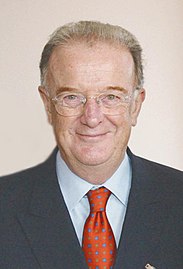
|

|
| Enrique Dominguez (L) President |
Germán del Caserío (SF) Prime Minister |
The president of Auratia is the head of state, commander-in-chief of the Auratian Armed Forces, and Auratia's chief representative abroad. The governors of the States select the president to serve for a seven-year nonrenewable term. The president appoints ambassadors, commissioned military officers, and other key government officials, promulgates and vetoes laws, ratifies treaties upon parliamentary approval, issues pardons and commutations, among other powers. The president is also ex officio Mayor of Cienflores. In practice, the president is mostly—though not entirely—a figurehead and excercises his powers on the advice and recommendation of the Commonwealth Cabinet. The president does retain certain discretionary powers, and certain presidents have prefered to be more involved in day-to-day politics. The current president is Enrique Santos Dominguez, who has been serving since 2015.
The prime minister of Auratia is the head of government. The president elevates a member of the Assembly whom he believes to command the confidence of the Assembly to the office of prime minister. The president also forms the prime minister's Cabinet and determines Cabinet members' portfolios, on the advice of the prime minister. The prime minister excercises executive authority through the Commonwealth Cabinet ("the Administration"), which is composed of ministers. The Cabinet and prime minister are collectively responsible to the president and both houses of the Senate, though only the president and Assembly may remove the Cabinet. The current prime minister is Sotirian Federation leader Germán del Caserío, who assumed office following the 2013 Auratian federal election.
Federal politics in Auratia best ascribes to the multi-party system. Two political parties, the Sotirian Federation and the Liberal Party, have dominated national politics, but these parties usually have to rely on support from minor parties in order to pass legislation or form a majority. The Sotirian Federation is most broadly Sotirian democratic, agrarian, and conservative, prioritizing the country's connection with Solarian Catholic values and traditions whilst advocating a social market economy. The Liberal Party is likewise considered centre-right on social issues, but advocates fiscal conservatism, secularism and economic liberalism. The Labour Party and National Front are other prominent political parties in Auratian politics, but neither has fielded a prime minister in over fifty years.
LGBTI rights
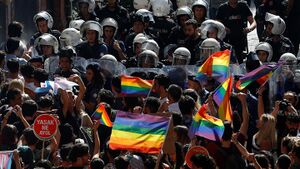
Among members of the Euclean Community, Auratia has the poorest rating in terms of protecting LGBTI rights. Homosexuals and transgenders enjoy little to no rights in Auratia. Of Auratia's eight States, five have officially decriminalized sodomy. In addition, only the state of Iustia Nova has some sort of legal framework to protect LGBTI+ individuals from workplace, education, or healthcare discrimination. No federal statute protects the rights or integrity of LGBTI Auratians, and laws protect businesses or people who discriminate against homosexuals on religious/moral grounds from lawsuits.
Same-sex couples are not recognized by any state's law, and no state allows for LGBT adoption. Homosexuals are barred from serving in the Auratian Armed Forces on threat of imprisonment. Auratia does not recognize foreign same-sex unions, and Auratians found to move abroad to marry someone of the same sex are liable to have their citizenship stripped. Homosexual rights enjoy little support given in the country's conservative observance of Solarian Catholicism.
LGBT rights organizations are permitted in Auratia, but pride parades are regularly suppressed on the grounds that they violate public safety and the national conscience. Violence between LGBT activists and police culminated in the Palma pride riots of 2018.
Law

Auratia has a civil law system based principally upon Roman law and the inquisitorial system. Case law must be based upon and subordinate to statutes of the Senate. Though stare decisis (binding precedent) does not exist, courts are generally understood to lay down persuasive precedent through the doctrine of jurisprudence constante. In practice, the precedent of higher courts is understood to be de facto binding on lower courts. In their decisions, high courts are expected by tradition to offer ample ratio decidendi.
Though the Constitution of Auratia says very little about the nation's federal judicial system, it vests supreme judicial authority in the Supreme Court of Auratia, the court of last resort. The Constitution directs the Senate to establish a federal court system. The Judiciary Act 1828 divides the court system into ordinary district courts, which deal with civil and criminal litigation, and administrative district courts, which handle administrative law. Above these district courts are the respective courts of appeal. The Supreme Courts adjudicates both ordinary and administrative appeals. The courts are also responsible for judicial review of federal and state laws, treaties or administrative decisions.
Judges of federal courts are nominated by the Judicial Appointments Commission, of which the president of Auratia is the chairman, and approved in the Council by majority vote. The Constitution vests state legislatures the power to decide the structure and apportionment of their state courts, and all state supreme courts are subordinate to the Supreme Court of Auratia.
Federal law enforcement, prisons, internal security and domestic policy are managed by the Ministry of Home Affairs. The Attorney General is the government's chief legal advisor and representative in court. The Prosecutor General is responsible for directing federal criminal prosecution.
Administrative divisions
The Constitution of Auratia provides for the existence of eight states who, along with the federal government, form the framework of Auratia's federal system. State governments function in accordance to the states' constitutions, though the Constitution of Auratia dictates that the States must follow the principles of democracy. The States often share jurisdiction with the federal government, though the Constitution does grant the states special privilidges. Federal law is supreme over state laws, but the Constitution expressly prohibits the Senate from "repealing" state laws. Discrepancies in state and federal law are ajudicated in the courts.
State boundaries have only been redrawn once in 1868 to account for the territories of the former Kingdom of Iustia. These are the current states:
| ||||||||||||||||||||||||||||||||||||||||
Foreign relations
Auratia has been a member of Euclean Community since 2002, having joined in the wake of the Millennium Crisis of 2000. Auratia's membership in the EC is and has always been controversal. Before its succesful ascension into the supranational union, the country had previously rejected EC membership five times. Auratia was a founding member of the Community of Nations, as well as a member of the Aurean Forum and the International Trade Organization.
Much of Auratia's foreign relations focus on promoting its foreign policy, particularly its trade interests. Auratia is active in encouraging trade across the Gulf of Assonaire and the Solarian Sea.
Of non-EC nations, Auratia is particularly close to Etruria and Montecara, whom Auratians generally view as cultural and religious brethren. Auratia maintains close albeit sometimes rocky relations with its former colonies, such as Nuxica and Belmonte.
Military
The Auratian Armed Forces is the military of Auratia, consisting of the Army, Navy, and Marines. The Armed Forces have 95,192 active personnel and about 18,036 in reserve personnel. Enlistment into the Armed Forces is optional; conscription was ruled unconstitutional Gutiérrez v. the Commonwealth.
Reforms to the military after the Great War gelded the military's authority, reducing it to a defense force with limited mobilization powers. To ensure civilian control of the military, day-to-day operations are supervised by civil servants under the Ministry of Defense and carried out by military officers. The president of Auratia is the nation's commander-in-chief. The president appoints commissioned officers on the recommendation of the Cabinet who must be approved by a two-thirds super-majority vote in the Senate. The president may, in times of invasion, mobilize the Armed Forces on the recommendation of the Cabinet, but these decisions must be approved by the Senate. Only the Senate may declare war or authorize troop deployments for greater than thirty days.
The Auratian Armed Forces has no central command, and it has never been deployed in any offensive or defensive capacity since the Great War. The Armed Forces do assist in humanitarian aid operations.
Economy
Agriculture
Tourism
Transport
Trade
Energy
Science and technology
Demographics
Ethnic groups
Language
Religion
Health
Education
Largest cities
Culture
Art
Literature
Cinema
Cuisine
Music
Dance
Fashion
Media
Sports
Society
Symbols
Flag
The flag of Auratia, officially la Bandera de la Mancomunidad, ("the Flag of the Commonwealth), often refered to as El Espíritu ("The Spirit"), is a tricolour featuring a white diagonal band radiating from the lower hoist-side dividing an upper blue triangle and a lower gold triangle. Blue and yellow are the traditional colors of the Kingdom of Auratia. Blue symbolizes the waters surround the Auratian Peninsula, while the gold represents the nation's culural wealth, historic tradition, relationship to the Solarian Catholic Church, and importance as a trade hub. White, which was the original color of Auratian republicans during the Alzamiento, is said to represent the nation's purity and commitment to democracy.
A common misconseption is that the Auratian flag was used by republican forces during the Alzamiento in 1817-1820. The current flag of Auratia was actually designed in 1831. During the Alzamiento, there was no single flag used to represent the anti-monarchist forces, and every state generally had its own flag. The flag was created by a committee and present to the Senate by Luis Lobo, the country's second president. This misconception has contributed to the popularity of historical anachronisms portraying the Auratian flag during the Alzamiento when it never would have been seen.
Coat of Arms
The coat of arms of Auratia is the official coat of arms of the Commonwealth, its armiger. By law, the coat of arms must appear on all official documents produced by the federal government, including laws, ordinances, and reports. Like the Auratian flag, it was adopted in 1831. The Auratian coat of arms was deliberately designed to be simple and unlike the elaborate coats of arms of the Euclean monarchies. The eight stars represent the eight states of Auratia while the cross in lieu of where a crown would traditionally sit represents the nation's commitment to upholding the principles of Solarian Catholicism. In 1970, a star was added in the center to represent Cienflores, the nation's administrative capital.
Interestingly, the shade of blue on the coat of arms is slightly different from the shade on the flag. This is a design error that has never been fixed.




